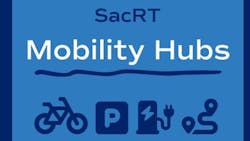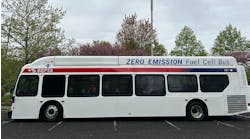The Sacramento Regional Transit District (SacRT), in partnership with the Sacramento Metropolitan Air Quality Management District (Sac Metro Air District) and Sacramento Clean Cities Coalition (Clean Cities), has begun developing Mobility Hubs at three light-rail stations.
SacRT has received $1.7 million in federal grant funding from the Joint Office of Energy and Transportation for the development of the Mobility Hubs. Additionally, the Sac Metro Air District may contribute up to $3 million to further bolster the benefits and amenities of the Mobility Hubs, including enhancements such as landscaping, lighting and other infrastructure improvements.
To kick start the project, the California Air Resources Board’s Sustainable Transportation Equity Program granted $500,000 for the creation of a Mobility Hub Implementation Plan, which will be led by Civic Thread. The SacRT Mobility Hub Implementation Plan will be a community-driven approach to identify and site which of SacRT’s light-rail stations should be prioritized for inclusion in the Sacramento Region’s 52 Mobility Hubs. The first three pilot locations have already been identified as part of the partnership with the Sac Metro Air District and Clean Cities.
The Mobility Hubs will serve as vital community hubs, strategically located within disadvantaged neighborhoods, and offer many transportation options aimed at reducing reliance on gas-powered and single-occupancy vehicles. Among the amenities provided at the hubs are electric vehicle (EV) carshare, bike and scooter share services, EV charging stations, carpool/vanpool connections and electric microtransit shuttles.
The following three stations have been selected for the Mobility Hubs:
- Marconi/Arcade Station
- Globe Station
- La Valentina/Alkali Flat Station
The grant funding from the Joint Office of Energy and Transportation enables SacRT to procure new electric shuttles for its on-demand microtransit service, SmaRT Ride, and expand service to include the new Mobility Hub at Globe Station.
“We are excited to embark on this journey toward creating Mobility Hubs that will serve as vibrant community centers, fostering sustainable transportation options and connectivity within our region,” said Henry Li, SacRT general manager and CEO. “Through strategic partnerships and innovative solutions, SacRT is committed to enhancing the quality of life for all residents while leading the charge towards a greener, more equitable future.”
“We are proud to support this pivotal first step towards establishing Mobility Hubs in our region. As we have identified in our coordinated regional planning, these hubs will not only enhance transportation accessibility, but also contribute significantly to our collective efforts for transportation electrification, reducing air and climate pollution and advancing equity,” said Alberto Ayala, executive director of the Sac Metro Air District. “Through collaborative initiatives like this, we are driving positive change and laying the groundwork for a cleaner, healthier future for our communities.”
The pilot project represents the first phase of a larger mobility initiative led by the Sac Metro Air District, aiming to introduce up to 52 Mobility Hubs across the Sacramento region. During a two-year period, SacRT will work on collaborating with EV vendors, acquiring electric shuttles and engaging in extensive community outreach to gather input on the features and services desired at each Mobility Hub. The project is anticipated to kick-off in the summer or fall of 2024. The goal is to develop, demonstrate and document the benefits, effectiveness and sustainability of e-mobility hubs, with a focus on providing zero-emission equity for disadvantaged communities.




